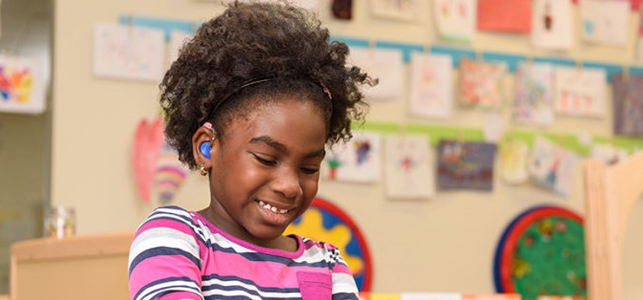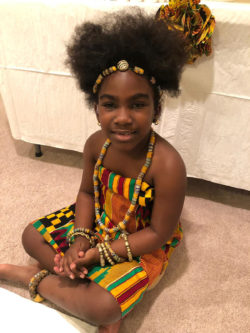
Hearing loss: Meet Danielle
Danielle Amoako has a lot to say about what makes her happy about kindergarten. She loves the work stations, playing with kitchen toys at recess and sitting “criss-cross applesauce” on her classroom carpet for activities. She considers homework a favorite activity and prides herself in being able to color inside the lines when she needs to.
“She’s come such a long way,” her mom Gloria acknowledges, overhearing her six-year-old readily share so much. “Three years ago, she had no vocabulary at all.”
Danielle has hearing loss and when she was two-and-a-half she underwent surgery to have a cochlear implant hearing device placed in her left ear. It was a big first step toward her becoming the bubbly, sometimes feisty, fun-to-be-around girl she is today.
A big decision: Newborn hearing testing
Born six weeks early, Danielle was referred to us for an in-depth assessment of her brain’s response to sound after she failed two newborn hearing screenings and showed little improvement in later testing with specialists near her family’s home in Chester.
“They found she had profound hearing loss in her left ear and mild to moderate hearing loss in her right,” Gloria explains. Since that day, a coordinated team that includes doctors, pediatric audiologists and our auditory therapist (a speech-language pathologist who is the only certified provider of listening and spoken language therapy in Richmond) has worked closely with Danielle and her family to bring sound to her world.
Hearing aids make sound that’s already there louder and Danielle’s parents opted to try this option first. But even with speech therapy and some early intervention services, Danielle still wasn’t saying words by the time she was two, which meant she likely wasn’t hearing enough to do so. (With such a young child it can be difficult to know exactly what they’re hearing as they can’t always tell you.) “Sometimes her degree of hearing loss can be managed with hearing aids which is what we were hoping for,” Gloria explains, “but she did not respond well to just hearing aids.”
Cochlear implants use a process that bypasses the inner ear and sends electronically created signals straight to the auditory nerve (our main nerve for hearing) and up to the brain. The implants can affect what limited hearing is already there, which was a concern for Gloria, but she realized that for Danielle to hear well and speak, they needed to consider an implant in the ear with profound loss. So, she set out to learn more.
Our audiology team and Dr. Raj Petersson, ear, nose and throat doctor and specialist in head and neck surgery, spent time talking with Gloria about the process in detail. Helping families obtain the knowledge they need to feel confident in health care decisions is one of many ways we are by their side. Gloria did research on her own as well, even getting a second opinion at Johns Hopkins, before deciding to pursue an implant. “The doctors and specialists I worked with at CHoR were wonderful about getting me to this point,” Gloria remarks. “I was skeptical at the beginning of this journey and they were always welcoming, always providing helpful information.”
Place, program and activating a cochlear implant
A cochlear implant includes a device that’s surgically placed under the skin behind the ear. This device receives electrical signals and sends them to the cochlea, the part of our hearing system that triggers our auditory nerve to send signals to the brain for hearing. It communicates wirelessly to a sound/speech processor, usually behind the ear, with a microphone that picks up sounds in the environment for the processor to make into the electrical signals.
Before an implant is fully activated, an audiologist programs the sound/speech processor based on how each individual may hear sounds. Audiologists also make adjustments over the months that follow as the brain begins to recognize and understand the new form of sounds coming through the implant. In Danielle’s case, the hearing aid in her right ear and implant in her left also need to be programmed together and sometimes adjusted.
Danielle’s device was activated – meaning the sound was fully turned on for the first time – about a month after Dr. Petersson surgically placed it. Right away she started to turn her head both ways toward different sounds. Before, she tended to turn her head to the right side only when trying hear or she’d look at mouths to read lips. “Then her eyes lit up when they turned the television on,” Gloria recalls. Further evidence good things were happening.
I want my ears
Learning to hear through an implant takes time and effort. Individuals need to learn to interpret what they’re hearing through the implant, which is where specialized speech therapy comes in.
Danielle’s auditory therapist worked with her on identifying sounds she was hearing and when she was being spoken to. They then focused on Danielle making her own sounds, and eventually recognizing and forming words. She’s now working on more complex speech and language skills. When she’d talk to Danielle during initial sessions, her therapist covered her mouth so Danielle had to listen to know what was being said, one of several techniques Danielle’s family learned to do at home to help Danielle practice her listening skills.
It was a lot for Danielle to focus on and take in at first, especially in the initial months of therapy. There was also much for her family learn about how to best support her in learning to use the implant and hearing aid together. When Danielle began to start each day saying “I want my ears” they knew they were on the right path. (Implants and hearing aids are usually not worn at night.)
Gloria says care that extends beyond the walls of the hospital, including being able to call or text for help or quick answers, made the journey easier. During a family trip to England last summer, Danielle’s implants malfunctioned. Gloria texted Danielle’s audiologist who worked with Cochlear Americas in coordination with Cochlear United Kingdom so they could get the replacement part and be sure it was programmed correctly. Within three days, Danielle’s implant was up and running again. “They’re just always on top of their game at CHoR,” Gloria says. “And Danielle LOVES coming.”
Background music
 Danielle is a big fan of music, especially gospel. After breakfast on weekends, she often asks to turn music on so she can dance along. “Her speech therapist told us it was important for her to hear lots of sounds after her implants and to try to always have something she could hear at home,” Gloria explains. “I love music and so we often had music on.”
Danielle is a big fan of music, especially gospel. After breakfast on weekends, she often asks to turn music on so she can dance along. “Her speech therapist told us it was important for her to hear lots of sounds after her implants and to try to always have something she could hear at home,” Gloria explains. “I love music and so we often had music on.”
Not afraid to share her voice, Danielle spends lots of time singing and pretending she’s an emcee on her karaoke machine. “She’s getting better,” Gloria laughs. Lately she’s also been using the microphone to tell her big sister and brother what to do. “So sometimes I have to hide it,” she adds.
Danielle turned six in December and they celebrated with a “come as your favorite princess party” that blended family tradition and fun. Gloria is from Ghana, West Africa, and Danielle dressed as an African princess in a dress made of kente cloth from Ghana (pictured). Her cake was decorated with this cloth and they sat on special floor pillows made from the material to celebrate. And of course, there was music. And dancing.
Watching her daughter dance around with joy or sing lyrics from gospel songs no doubt warms Gloria’s heart. It also confirms their well-researched decision and the benefits of the hard work along the way. “She’s just a very happy kid,” Gloria says thankfully.
And that – more than anything – is what’s music to our ears.
